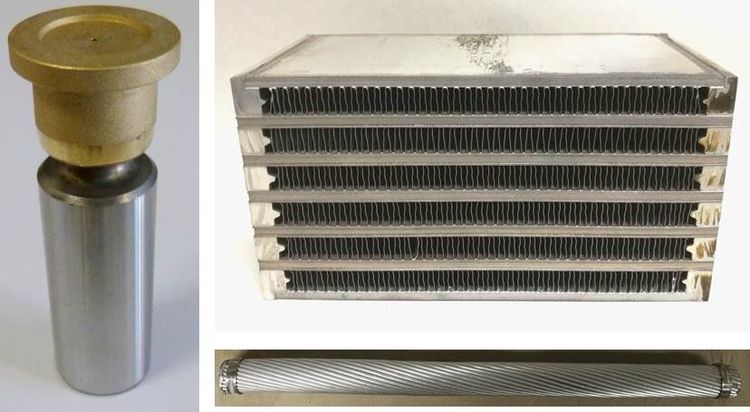Liquid-repellent surfaces with anti-icing, anti-fouling and low-friction properties
Study of the properties related to liquid repellence
Principal Investigators: Mariarosa Raimondo, Magda Blosi, Federico Veronesi
Involved personnel: Alessandro Corozzi, Guia Guarini, Andrea Brigliadori, Maria Caruso, Simone Fabbri
This research activity is focused on the study of the collateral properties of liquid-repellent surfaces (superhydrophobic and oleophobic). More in detail, the Smart Surfaces Group at ISSMC is able to design and fabricate coatings for surfaces with complex shapes to be tested in external setups, with the aim of studying their response in extreme work conditions.
Liquid-repellent coated surfaces showed properties like:
- Reduced ice and snow adhesion, thus easier removal of deposits from aluminum wires for the electric grid;
- Reduced fouling growth and adhesion on surfaces immersed in seawater;
- Reduced friction coefficient in hydrodynamic regime (e.g. inside oleodynamic pumps) and on floating surfaces (reduced frictional drag on hulls).
The influence of coating morphology and chemical composition on performances is studied in many different conditions. Specific attention is paid to the effects of surface roughness, which can significantly influence many phenomena occurring at the interface between the solid surface and the surroundings.
Equipment and Processes
The deposition of coatings based on ceramic nanoparticles (either from sol-gel synthesis or purchased as commercially available suspensions) is performed through techniques like dip coating, roller printing, and automated spray coating. The fabrication process must be chosen and tailored depending on the characteristics of the material to be coated, such as geometry, size, sensitivity to acidic and corrosive environments, resistance to high temperatures, etc.
Among the surfaces coated in the research activity:
- NACA air profiles for icing wind tunnel tests;
- 50 cm-long parts of ACSR 31.5 electric wires;
- Brass slippers and steel swashplates for oleodynamic axial pumps;
- 50 x 30 cm2 aluminum foils for frictional drag tests;
- Ship hull surfaces made of metallic or composite materials;
- Fins made in anodized aluminum for heat exchangers for automotive.

Main collaborations
- Office of Naval Research ONR, United States
- Institute for Agricultural and Earthmoving Machines CNR-IMAMOTER, Ferrara (Dr. Pietro Marani)
- Instituto Nacional de Técnica Aeroespacial INTA, Spain (Dr. Alina Aguero-Bruna)
- Institute of Marine Engineering CNR-INM, Rome (Dr. Elena Ciappi)
Projects
Publications and Patents
- A. Cecere, D. De Cristofaro, R. Savino, G. Boveri, M. Raimondo, F. Veronesi, F. Oukara, R. Rioboo, Visualization of liquid distribution and dry-out in a single-channel heat pipe with different wettability, Experimental Thermal and Fluid Science, 96, 234–242 (2018), DOI: 10.1016/j.expthermflusci.2018.03.012
- M. Raimondo, F. Veronesi, G. Boveri, G. Guarini, A. Motta, R. Zanoni, Superhydrophobic properties induced by sol-gel routes on copper surfaces, Applied Surface Science, 422, 1022–1029 (2017), DOI: 10.1016/j.apsusc.2017.05.257
- G. Rizzo, G. P. Massarotti, A. Bonanno, R. Paoluzzi, M. Raimondo, M. Blosi, F. Veronesi, A. Caldarelli, G. Guarini, Axial piston pumps slippers with nanocoated surfaces to reduce friction, International Journal of Fluid Power, 16 (1), 1 – 10 (2015), DOI: 10.1080/14399776.2015.1006979
- A. Caldarelli, M. Raimondo, F. Veronesi, G. Boveri, G. Guarini, Sol-gel route for the building up of superhydrophobic nanostructured hybrid-coatings on copper surfaces, Surface & Coatings Technology 276, 408 – 415 (2015), DOI: 10.1016/j.surfcoat.2015.06.037
- M. Raimondo, M. Blosi, A. Caldarelli, G. Guarini, F. Veronesi, Wetting behavior and remarkable durability of amphiphobic aluminum alloys surfaces in a wide range of environmental conditions, Chemical Engineering Journal 258, 101 – 109 (2014), DOI: 10.1016/j.cej.2014.07.076